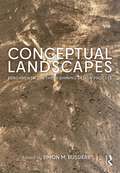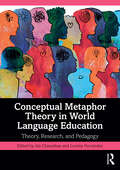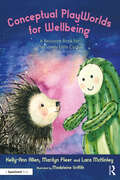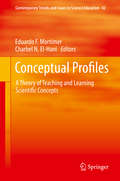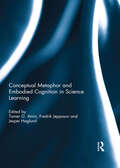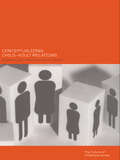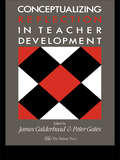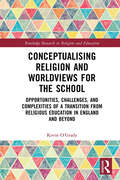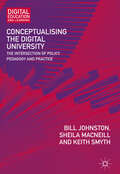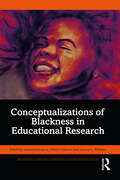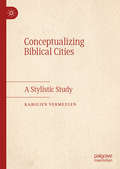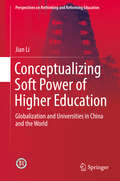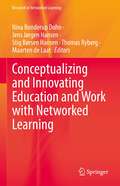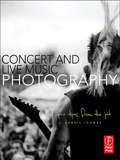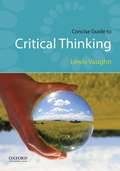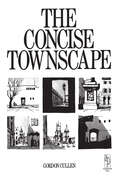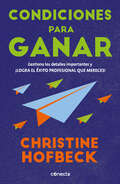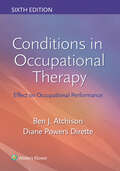- Table View
- List View
Conceptual Integrated Science--explorations
by Paul HewittFrom the author of the number one textbooks in physical science and physics comes the eagerly awaiting new text, Conceptual Integrated Science. Hewitt's critically acclaimed conceptual approach has led science education for 30 years and now tackles integrated science to take student learning to a new level. Using his proven conceptual approach, accessible writing, and fun and informative illustrations, Hewitt and his team of science experts have crafted a text that focuses on the unifying concepts and real-life examples across physics, chemistry, earth science, biology, and astronomy.The book includes best-selling author Paul Hewitt's proven pedagogical approach, straight-forward learning features, approachable style, and rigorous coverage. The result is a wide-ranging science text that is uniquely effective and motivational. Conceptual Integrated Science is accompanied by an unparalleled media package that combines interactive tutorials, interactive figures, and renowned demonstration videos to help students outside of class and instructors in class.
Conceptual Landscapes: Fundamentals in the Beginning Design Process
by Simon M. BussiereConceptual Landscapes explores the dilemma faced in the early moments of design thinking through a gradient of work in landscape and environmental design media by both emerging and well-established designers and educators of landscape architecture. It questions where and, more importantly, how the process of design starts. The book deconstructs the steps of conceptualizing design in order to reignite pedagogical discussions about timing and design fundamentals, and to reveal how the spark of an idea happens – from a range of unique perspectives. Through a careful arrangement of visual essays that integrate analog, digital, and mixed-media works and processes, the book highlights differences between diverse techniques and triggers debate between design, representation, technology, and creative culture in the field. Taken together, the book’s visual investigation of the conceptual design process serves as a learning tool for aspiring designers and seasoned professionals alike. By situating student work alongside that of experienced teachers and landscape architects, the book also demystifies outdated notions of individual genius and sheds new light on the nearly universally messy process of discovery, bridged across years and diverse creative vocabularies in the conceptual design process. Lavishly illustrated with over 210 full color images, this book is a must-read for students and instructors in landscape architecture.
Conceptual Metaphor Theory in World Language Education: Theory, Research, and Pedagogy
by Loretta FernándezThis edited collection explores the scholarly and pedagogical implementations of Conceptual Metaphor Theory (CMT) in world language education. The chapters offer a diverse range of theoretical and pedagogical perspectives as well as methodologies aiming to achieve the following objectives: Introduce novice linguists, novice researchers, and pre-service language teachers to CMT, its extensions, and its applications, while providing an overview of the current state of the discipline; Shed light on new research and pedagogical practices for linguists, researchers, and language educators at all levels; Present theoretically founded and research-based examples of the pedagogical application of CMT across multiple world languages, including English, French, Mandarin, and Spanish; Highlight the experiences and perspectives of practitioner educators who have implemented CMT in world language education. By addressing these objectives, the book aims to provide a comprehensive and insightful exploration of CMT’s role in world language education, offering guidance and inspiration for both researchers and practitioners in the field.
Conceptual PlayWorlds for Wellbeing: A Resource Book for the Lonely Little Cactus (Building Belonging and PlayWorlds for Wellbeing)
by Marilyn Fleer Kelly-Ann Allen Lara McKinleyFor effective use, this book should be purchased alongside the story book, The Lonely Little Cactus: A Story About Friendship, Coping, and Belonging. Both books can be purchased together as a set, Building Conceptual PlayWorlds for Wellbeing: The Lonely Little Cactus Story Book and Accompanying Resource Book. This vital resource uses the evidence-driven Conceptual PlayWorlds model of intentional teaching developed by Professor Marilyn Fleer to provide supporting classroom- or home-based activities to help children aged between 4 and 8 solve challenges and learn wellbeing concepts through play. Intended for use with the accompanying picture story book, The Lonely Little Cactus, a tale about a cactus that feels lonely living in the desert, this guide offers imagery-rich scenarios, including 20 unique activities so children have an opportunity to experientially grasp wellbeing concepts that can be otherwise difficult to explain. This resource guides educators through a range of wellbeing activities including: Identifying feelings Coping (social support, problem solving, and self-regulation) Friendships (relationship building, working together, time with friends, social skills) Positive emotions (happiness, joy, doing something you love, enjoyment, fun) Relaxation strategies Belonging and inclusion (working together, collaboration, joining in play, including others). Offering a unique opportunity for children to learn about psychological strategies while being engaged in a beautiful narrative and visually captivating illustrations, this is the ideal resource for educators, support staff, practitioners and parents looking to help children understand and manage their feelings.
Conceptual Profiles: A Theory of Teaching and Learning Scientific Concepts (Contemporary Trends and Issues in Science Education #42)
by Eduardo F. Mortimer Charbel N. El-HaniThe language of science has many words and phrases whose meaning either changes in differing contexts or alters to reflect developments in a given discipline. This book presents the authors' theories on using 'conceptual profiles' to make the teaching of context-dependent meanings more effective. Developed over two decades, their theory begins with a recognition of the coexistence in the students' discourse of those alternative meanings, even in the case of scientific concepts such as molecule, where the dissonance between the classical and modern views of the same phenomenon is an accepted norm. What began as an alternative model of conceptual change has evolved to incorporate a sociocultural approach, by drawing on ideas such as situated cognition and Vygotsky's influential concept of culturally located learning. Also informed by pragmatist philosophy, the approach has grown into a well-rounded theory of teaching and learning scientific concepts. The authors have taken the opportunity in this book to develop their ideas further, anticipate and respond to criticisms--that of relativism, for example--and explain how their theory can be applied to analyze the teaching of core concepts in science such as heat and temperature, life and biological adaptation. They also report on the implementation of a research program that correlates the responsiveness of their methodology to all the main developments in the field of science education. This additional material will inform academic discussion, review, and further enhancement of their theory and research model.
Conceptual Shifts and Contextualized Practices in Education for Glocal Interaction: Issues and Implications (Intercultural Communication and Language Education)
by Ali Fuad Selvi Nathanael RudolphThis book employs the realm of English Language Teaching (ELT) as a discursive point of departure to explore how individuals, groups, entities and institutions apprehend, embrace, deal with, manipulate, problematize and resist glocal flows of people, ideas, information, goods, and technology. It apprehends and attends to tensions arising from the fluidly local-global construction and negotiation of borders of identity and interaction within a diverse array of contexts and English education therein. These tensions, whether conceptual or pedagogical, may arise in and through governmental and institutional policymaking, teacher training, or curriculum and materials development, and in the learning experience both within and beyond the classroom, as teachers and students engage with course content and each other.
Conceptual and Procedural Knowledge: The Case of Mathematics
by James HiebertFirst Published in 1986. Routledge is an imprint of Taylor & Francis, an informa company.
Conceptual metaphor and embodied cognition in science learning
by Tamer G. Amin, Fredrik Jeppsson and Jesper HaglundScientific concepts are abstract human constructions, invented to make sense of complex natural phenomena. Scientists use specialised languages, diagrams, and mathematical representations of various kinds to convey these abstract constructions. This book uses the perspectives of embodied cognition and conceptual metaphor to explore how learners make sense of these concepts. That is, it is assumed that human cognition – including scientific cognition – is grounded in the body and in the material and social contexts in which it is embedded. Understanding abstract concepts is therefore grounded, via metaphor, in knowledge derived from sensory and motor experiences arising from interaction with the physical world. The volume consists of nine chapters that examine a number of intertwined themes: how systematic metaphorical mappings are implicit in scientific language, diagrams, mathematical representations, and the gestures used by scientists; how scientific modelling relies fundamentally on metaphor and can be seen as a form of narrative cognition; how implicit metaphors can be the sources of learner misconceptions; how conceptual change and the acquisition of scientific expertise involve learning to coordinate the use of multiple implicit metaphors; and how effective instruction can build on recognising the embodied nature of scientific cognition and the role of metaphor in scientific thought and learning. The volume also includes three extended commentaries from leading researchers in the fields of cognitive linguistics, the learning sciences, and science education, in which they reflect on theoretical, methodological and pedagogical issues raised in the book. This book was originally published as a special issue of the International Journal of Science Education.
Conceptualising Child-Adult Relations
by Berry Mayall Leena AlanenConceptualising Child-Adult Relations focuses on how children conceptualise and experience child-adult relations. The authors explore the idea of generation as a key to understanding children's agency in intersection with social worlds which are largely organised and ordered by adults. The authors explore two interconnected themes: how children define the division of labour between children and adults, and how far children regard themselves as constituting a seperate group. This book is ground-breaking in its focus on the variety and commonality in children's lives and views across a broad range of contexts. It provides innovative theoretical approaches to the growing study of childhood by homing in on intergenerational relations as a main concept, and draws attention to links across the main sites of children's lives such as the home, neighbourhood and school. Moreover, for policy related issues, this book provides food for thought about the social conditions and status of childhood, and the factors structuring it.
Conceptualising Reflection in Teacher Development
by Peter Gates James CalderheadFirst published in 1993. Routledge is an imprint of Taylor & Francis, an informa company.
Conceptualising Religion and Worldviews for the School: Opportunities, Challenges, and Complexities of a Transition from Religious Education in England and Beyond (Routledge Research in Religion and Education)
by Kevin O'GradyThis timely volume addresses current debates surrounding the transition from the teaching of religious education (RE) to the more holistic subject of Religion and Worldviews (R&W) in England, and posits criteria for best practice among educators in varied settings and in a broader international context. By examining empirical sources, governmental reports, and in particular the 2018 final report from the Commission on Religious Education (CORE), the volume suggests key principles needed to guide the transition and ensure that R&W is effectively integrated into curricula, pedagogy, and teaching resources to meet the needs of all student groups. By effectively conceptualising R&W, the volume gives particular attention to the intersections of the subject with democratic citizenship education, intercultural competence, and religious literacy. This text will benefit researchers, academics, and educators with an interest in religious education and teacher education as well as the philosophy and sociology of education more broadly. Those interested in education policy and politics, as well as citizenship and schooling in the UK, will also benefit from this volume.
Conceptualising the Digital University: The Intersection of Policy, Pedagogy and Practice (Digital Education and Learning)
by Bill Johnston Sheila MacNeill Keith SmythDespite the increasing ubiquity of the term, the concept of the digital university remains diffuse and indeterminate. This book examines what the term 'digital university' should encapsulate and the resulting challenges, possibilities and implications that digital technology and practice brings to higher education. Critiquing the current state of definition of the digital university construct, the authors propose a more holistic, integrated account that acknowledges the inherent diffuseness of the concept. The authors also question the extent to which digital technologies and practices can allow us to re-think the location of universities and curricula; and how they can extend higher education as a public good within the current wider political context. Framed inside a critical pedagogy perspective, this volume debates the role of the university in fostering the learning environments, skills and capabilities needed for critical engagement, active open participation and reflection in the digital age. This pioneering volume will be of interest and value to students and scholars of digital education, as well as policy makers and practitioners.
Conceptualizations of Blackness in Educational Research (Indigenous and Decolonizing Studies in Education)
by Rosalind Hampton Sefanit Habtom Joanna L. WilliamsConceptualizations of Blackness in Education engages the specific junction of educational research and multiple theorizations of Blackness. In this volume, authors narrate how they have come to conceptualize Blackness through reading, writing, research, training, and practice. The contributors reflect a range of personal and political perspectives and experiences, disciplinary roots, and career stages. The stories in each chapter are intended to encourage more theoretically reflexive and vulnerable conversations among scholars of Black Studies in Education committed to reducing inequality in the lives of Black youth. They are not merely stories about theory; the stories are theories themselves.
Conceptualizing Biblical Cities: A Stylistic Study
by Karolien VermeulenThis book offers a comprehensive treatment of the city image in the Hebrew Bible, with specific attention to stylistics. By engaging with spatial theory (Lefebvre 1974, Soja 1996), the author develops a new framework to analyse the concept of ‘city’, arguing that a set of conceptual images defines the Biblical Hebrew city, each of them constructed using the same linguistic toolkit. Contrary to previous studies, the book shows that biblical cities are not necessarily evil or female. In addition, there is no substantial difference between the metaphorical images used for Jerusalem and those used for other cities. This book will be of interest to students and scholars of stylistics, urban studies, critical-spatial theory and biblical studies (especially Biblical Hebrew).
Conceptualizing Environmental Citizenship for 21st Century Education (Environmental Discourses in Science Education #4)
by Pedro Reis Andreas Ch. Hadjichambis Demetra Paraskeva-Hadjichambi Jan Činčera Jelle Boeve-de Pauw Niklas Gericke Marie-Christine KnippelsThis Open Access book is about the development of a common understanding of environmental citizenship. It conceptualizes and frames environmental citizenship taking an educational perspective. Organized in four complementary parts, the book first explains the political, economic and societal dimensions of the concept. Next, it examines environmental citizenship as a psychological concept with a specific focus on knowledge, values, beliefs and attitudes. It then explores environmental citizenship within the context of environmental education and education for sustainability. It elaborates responsible environmental behaviour, youth activism and education for sustainability through the lens of environmental citizenship. Finally, it discusses the concept within the context of different educational levels, such as primary and secondary education in formal and non-formal settings. Environmental citizenship is a key factor in sustainability, green and cycle economy, and low-carbon society, and an important aspect in addressing global environmental problems. It has been an influential concept in many different arenas such as economy, policy, philosophy, and organizational marketing. In the field of education, the concept could be better exploited and established, however. Education and, especially, environmental discourses in science education have a great deal to contribute to the adoption and promotion of environmental citizenship.
Conceptualizing Soft Power of Higher Education: Globalization and Universities in China and the World (Perspectives on Rethinking and Reforming Education)
by Jian LiThis book examines the globalization trends in higher education from an international political science perspective, using Nye’s theory of soft power to explore the rationale behind it. It focuses on conceptualizing the Soft Power Conversion Model of Higher Education, which is embedded in the globalization of higher education, and analyzes the globalization of Chinese higher education reform.Also, this book provides innovative and unique viewpoints on conceptualizing and mapping the globalization and internationalization of higher education, especially for current Chinese higher education (1949-2016). It discusses and illustrates cutting-edge concepts of global higher education, such as global learning, global competency, and global citizenship and refines them in the conceptualized soft power conversion model of higher education.This book reports on and enriches the theoretical concept of global education, and provides practical insights into global learning, global citizenship and global competency for Chinese undergraduate students.
Conceptualizing and Contextualizing Higher Education with Chinese Characteristics: Ontological and Epistemological Dimensions (Perspectives on Rethinking and Reforming Education)
by Jian Li Xudong ZhuThis book provides a fresh and unique overview of the modernization and internationalization of Chinese higher education, focusing on Chinese higher education from 1949 to 2018. It presents the Ontological Positivism Model (Conceptualization-Explicit-Formal-Share), concentrating on concepts of Chinese higher education.The book is intended for scholars and researchers in the field of comparative higher education, administrators and stakeholders in education management and graduate students majoring in higher education.
Conceptualizing and Innovating Education and Work with Networked Learning (Research in Networked Learning)
by Thomas Ryberg Maarten De Laat Nina Bonderup Dohn Stig Børsen Hansen Jens Jørgen HansenThe chapters in this book build upon selected research papers from the 12th International Networked Learning Conference 2020, hosted by University of Southern Denmark, Kolding. The selected chapters were chosen as cutting-edge research on networked learning which reflected focal discussion points during the conference such as: new demands on teachers in online and hybrid learning environments; organization of professional learning to meet and reflect on these demands; support of educators and students’ digital literacy; the interaction of human and technological agents in networked learning; and the development of new of networked learning designs to critically and creatively make use of technological possibilities. The book is organized into three main sections: 1) Professional learning, 2) Learning networks’ development and use of digital resources, and 3) Innovating Networked Learning. Preceding the three main sections is a first chapter, which presents a discourse analysis of how the term “networked learning” has been used in the papers at previous Networked Learning Conferences. The concluding chapter draws out perspectives from the chapters and point to emerging issues within the field of networked learning.
Concerning the Spiritual in Art
by Wassily KandinskyPioneering and Exploring the Spiritual Revolution in Modern Art In the early 20th century, the pioneering and celebrated painter Wassily Kandinsky (1866-1944) wrote this groundbreaking work advocating a powerful role for spirituality in driving the creation of modern art. Voicing his own strong opinions as well as the philosophical passions of his peers, Kandinsky urged traditional artists to break free from the limiting restraints of the material world in their work. By faithfully using their own uninhibited thoughts and inner emotions for inspiration-essentially channeling the human spirit instead of representing material concerns-he believed that artists could transcend the norms of the time to reach new levels of abstract expression and aesthetic beauty. Likewise, he also challenged the viewing public to admire art with a fierce spiritual hunger. With insightful explorations of form and color theory, creative inspiration, psychology, religion, music, ethics, and even politics, Kandinsky makes a strong case for his artistic revolution. The movement he inspired with his theories played a pivotal role in the development of modern art, particularly in the growth and evolution of abstract painting. Featuring an enlightening introduction by the book's translator, Michael T. H. Sadler, providing generational and cultural context for Kandinsky and his work, Concerning the Spiritual in Art gives testimony to the mind and creative expression of Kandinsky and other artists of his generation. This seminal and thought-provoking book exploring the heart of the artistic endeavor belongs in the library of every serious artist and student of modern art.
Concert and Live Music Photography: Pro Tips from the Pit
by J. Dennis ThomasIf you've ever wanted to take dynamic and vibrant digital photos of your favorite band in concert, but aren't sure how to tackle such obstacles as approaching the stage, tricky lighting situations, or even what equipment to use, then look no further! Concert and Live Music Photography is a comprehensive guide to shooting live music performances, providing you with the right information on equipment, camera settings, composition, and post-processing to get the best out of each performance shot. J. Dennis Thomas, whose work has appeared in such magazines as Rolling Stone, SPIN, and Country Weekly, shares tips on lighting, common problems, etiquette, and recommended camera settings for shooting in a variety of different venues, including clubs, bars, outdoor concerts, theatres, stadiums, and arenas. He also explains how to get the right credentials to get you closer to each performance. Jam packed with over 160 photos from today's top concerts, this book will not only give you the information you need to start taking rockin' photos of your favorite musicians, but will spark your creativity when you're anticipating the next shot. For the on-the-go photographer, a cool companion website features additional tips, venue troubleshooting, and an equipment checklist when you need to think on your feet while running to another gig.
Concise Guide To Critical Thinking
by Lewis VaughnLewis Vaughn's Concise Guide to Critical Thinking offers a compact, clear, and economical introduction to critical thinking and argumentative writing. Based on his best-selling text, The Power of Critical Thinking, Fifth Edition, this affordable volume is more manageable than larger textbooks yet more substantial than many of the smaller critical thinking handbooks.
Concise Townscape
by Gordon CullenThis book pioneered the concept of townscape. 'Townscape' is the art of giving visual coherence and organization to the jumble of buildings, streets and space that make up the urban environment. It has been a major influence on architects, planners and others concerned with what cities should look like.
Condiciones para ganar: Gestiona los detalles importantes y ¡logra el éxito profesional que mereces!
by Christine HofbeckCon las condiciones adecuadas, TODOS pueden convertirse en ganadores Seamos sinceros: el éxito profesional no se construye únicamente con trabajo, sino en la manera en que éste se presenta. Pequeños ajustes en su entrega pueden derivar en mejoras sustanciales en el resultado final. La gente, los productos y las ideas no solo triunfan porque sean excelentes en sí mismos, sino también porque se revelan en condiciones ganadoras. Condiciones para ganar es un libro tan esclarecedor como estimulante que logrará que las ideas de tu trabajo y tú mismo tengan mayor visibilidad, aceptación y reconocimiento. Con este libro podrás mostrarle al mundo de lo que eres capaz y muy probablemente sea más de lo que tú mismo te imaginas.
Condition Critical: Key Principles For Equitable And Inclusive Education
by Mara Sapon-Shevin Diana Lawrence-Brown Alfredo Artiles Elizabeth KozleskiThis important book provides a unique merging of disability studies, critical multiculturalism, and social justice advocacy to develop both the knowledge base and the essential insights for understanding and implementing fully inclusive education. Although inclusion is often viewed in schools as primarily serving students with disabilities, this volume expands the definition to include students with a broad range of traditionally marginalized differences (including but not limited to disabilities, cultural/linguistic/racial background, gender, sexual orientation, religion, and class). Chapters provide 12 key principles important to developing and applying a critical perspective toward educating diverse students and promoting equity and inclusion.
Conditions in Occupational Therapy: Effect on Occupational Performance
by Ben Atchison Diane DiretteLippincott® Connect Featured Title The only text covering the pathophysiology of common diseases specifically relative to Occupational Therapy practice, Conditions in Occupational Therapy: Effect on Occupational Performance, 6th Edition, combines the most up-to-date insights and an engaging approach to ready students for success from the classroom to clinical settings. This updated 6th Edition is fully aligned with the most current DSM-5 and Occupational Therapy Practice Framework, 4th Edition, and adds new chapters reflecting recent advances in the management of infectious diseases, general deconditioning, musculoskeletal pain, amputations, and sickle cell anemia. Each chapter follows a consistent format, presenting an opening case followed by descriptions and definitions, etiology, incidence and prevalence, signs and symptoms, diagnosis, course and prognosis, medical/surgical management, impact on occupational performance, and two case illustrations. Rounded out with robust instructor resources and new full-color imagery, this bestselling resource is an essential tool for today’s occupational therapy and occupational therapy assistant students.

